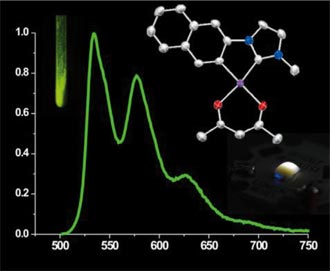|
The imidazolium salt 3-methyl-1-(naphthalen-2-yl)-1H-imidazolium iodide (2) has been treated with silver(I) oxide and [{Pt(μ-Cl)(η3-2-Me-C3H4)}2] (η3-2-Me-C3H4=η3-2-methylallyl) to give the intermediate N-heterocyclic carbene complex [PtCl(η3-2-Me-C3H4)(HCC*-κC*)] (3) (HCC*-κC*=3-methyl-1-(naphthalen-2-yl)-1H-imidazol-2-ylidene). Compound 3 undergoes regiospecific cyclometallation at the naphthyl ring of the NHC ligand to give the five-membered platinacycle compound [{Pt(μ-Cl)(CC*)}2] (4). Chlorine abstraction from 4 with β-diketonate Tl derivatives rendered the corresponding neutral compounds [Pt(CC*)(L-O,O′)] {L=acac (HL=acetylacetone) 5, phacac (HL=1,3-diphenyl-1,3-propanedione) 6, hfacac (HL=hexafluoroacetylacetone) 7}. All of the compounds (3–7) were fully characterized by standard spectroscopic and analytical methods. X-ray diffraction studies were performed on 5–7, revealing short Pt-Pt and π–π interactions in the solid-state structure. The influence of the R-substituents of the β-diketonate ligand on the photophysical properties and the use of the most efficient emitter, 5, as phosphor converter has also been studied.
|

